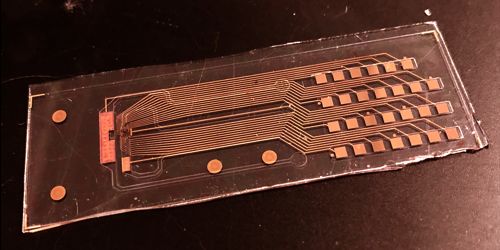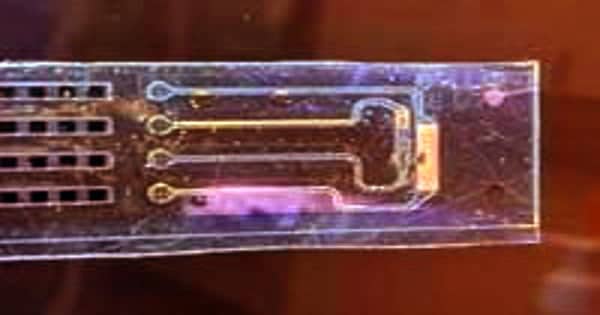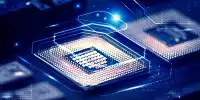Bioelectronics device achieves control of cell membrane voltage
The device used to control membrane voltage in living cells involves an array of bioelectronic proton pumps that add or remove hydrogen ions from the solution next to cultured human stem cells. Every living cell maintains a voltage across the cell membrane that results from differences in the concentrations of charged ions inside and outside the cell. The system is controlled by a machine learning algorithm that tracks how the membrane voltage responds to stimuli from the proton pumps. Often called the membrane potential or resting potential, this voltage is regulated by ion channels in the cell membrane and plays important roles in cell physiology and functions such as proliferation and differentiation. Proton pump arrays were fabricated on transparent substrates with integrated microfluidic channels to enable on-chip cell culture and monitoring of device performance and cell responses via fluorescence microscopy.
Every living cell maintains a voltage across the cell membrane that results from differences in the concentrations of charged ions inside and outside the cell. Controlling cells with bioelectronics is difficult due to the complex ways cells respond to changes in their environment and the natural self-regulating feedback process known as homeostasis. From the simplest unicellular organisms to complex animals, feedback control based on sensing and actuation is a staple of self‐regulation in biological processes and is a key to life itself. Cells regulate ion movements to maintain a steady membrane voltage, so the researchers had to develop a system that could counteract this natural response. Malfunctioning of this control loop can often lead to disease or death.
“Biological feedback systems are fundamental to life, and their malfunctioning is often involved in diseases. This work demonstrates that we can tweak this feedback using a combination of bioelectronic devices actuated by machine learning, and potentially restore its functioning,” said Marco Rolandi, professor and chair of electrical and computer engineering at the UC Santa Cruz Baskin School of Engineering.
Bioelectronic devices that interface electronics with biological systems can be used for sensing and actuation of biological processes and have the potential for novel therapeutic applications. The researchers developed a system involving an array of bioelectronic proton pumps that add or remove hydrogen ions from solution in proximity to cultured human stem cells. Due to the complexity of biological systems and the challenge of affecting their innate self‐regulation, closing the loop between sensing and actuation with bioelectronics is difficult to achieve. The cells were genetically modified to express a fluorescent protein on the cell membrane that responds to changes in membrane voltage. The system is controlled by a machine learning algorithm that tracks how the membrane voltage responds to stimuli from the proton pumps.
“It is a closed-loop system, in that it records the behavior of the cells, determines what intervention to deliver using the proton pumps, sees how the cells react, then determines the next intervention needed to achieve and maintain the membrane voltage status we desire,” Rolandi explained.
Gomez, who developed the machine learning algorithm, said the algorithm is not trained on any data in advance and does not rely on a model of the system. Instead, the “learning” happens in real-time as the neural network responds to input regarding the current state of the membrane voltage.

Life is built upon closed‐loop feedback and regulation systems that maintain a delicate balance of environmental and metabolic conditions that support cellular function. Because the membrane voltage of stem cells is different from that of mature, differentiated cells, the researchers are interested in the possibility of using the system to induce and direct the differentiation of stem cells into specific cell types. They did not, however, explicitly look at cell differentiation in this proof-of-concept study. Bioelectronic devices interface electronic devices with biology with potential for sensing and actuation.
A challenge for bioelectronic devices is translating between ionic and biochemical signals that dominate biology into electronic currents in the devices and vice versa. More broadly, the combination of bioelectronics and machine learning in a closed-loop biohybrid system has many potential applications in regenerative medicine and synthetic biology, Rolandi said. He noted that the results of this study will inform the team’s work on a major effort to develop a “smart bandage” providing bioelectronic intelligent control of wound regeneration.
Bioelectronics bridges natural systems and electronic devices by translating ionic signals in the body into electronic signals for sensing and control. “This study is an important proof of concept for the use of bioelectronics and machine learning to control cell functions,” he said. This research was funded by the Defense Advanced Research Projects Agency (DARPA).















